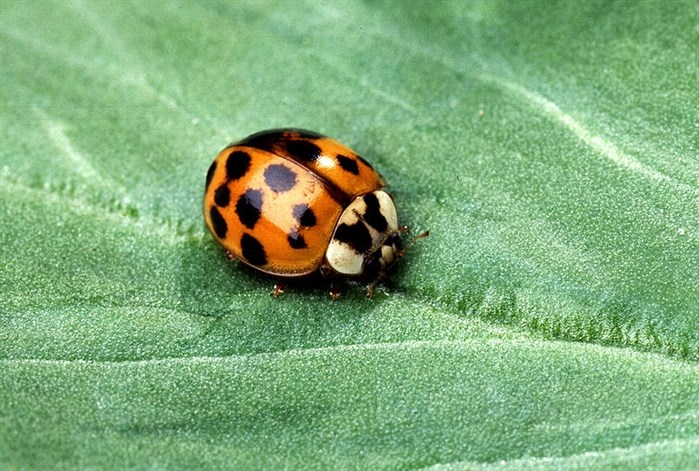
The Asian multicoloured lady beetle is identifiable by its false "eyes" — twin white football-shaped markings behind the head — and an M-shaped marking.
Image Credit: United States Department of Agriculture
September 26, 2018 - 4:33 PM
NORTH OKANAGAN - At first, Danielle Shetler thought the mass congregation of ladybugs at her new Spallumcheen home near Vernon was a sign of good fortune.
“Our friends said ‘it will bring you good luck,’” Shetler says. “At first, we thought it was pretty cool.”
Most will agree the tiny, fire engine red, polka-dotted bugs are among the cuter insects out there. Even their name has some charm.
But, as Shetler and her family found out, they lose their charm fast when there’s more than a few of them.
Since their initial arrival, Shetler says the ladybugs have multiplied by the hundreds if not thousands, and they are making life in the country a little uncomfortable.
“You can’t even go onto the balcony because, like, 30 of them will attach to you and start biting you,” she says.
She likens the bite to a “light prick” — not as bad as a bee sting but not pleasant either. While many people believe ladybugs don’t bite, some of them do. In Canada, the Asian lady beetle (which was introduced into North America in the 1970s to control aphids and other crop-eating inspects) does in fact bite.
The Asian lady beetle can be identified by an M-shaped marking just behind its head. Shetler says this is the type that have descended in and around her home. A video shot by Shetler shows the sheer volume of ladybugs crawling and flying around her home. She posted it on Facebook and area residents were quick to point out that they've been victims too, both this year and previously.
“There are so many I would rather have bad luck. It’s gross,” Shetler says.
The worst part, she says, was finding a hoard of them in her dog’s mouth.
“My dog started getting sick two days ago, she was foaming at the mouth, Shetler says. “I thought she’d been poisoned so I took her to the vet.”
The vet suspected a poisoning of some sort, but it wasn’t until a couple days later that Shetler, having looked online for information about ladybugs and dogs, checked inside her dog’s mouth and discovered it was filled with the bugs.
“The whole roof of her mouth was covered in these stupid bugs,” she says. “I was in panic mode trying to get them off.”
A simple Google search shows that other canines have had run-ins with lady beetles. According to PetMD, the Asian lady beetle has a tough exoskeleton that makes it stick inside a dog’s mouth like a popcorn kernel. Not only that, but the beetles also secrete a poisonous chemical as a defence mechanism. This chemical is corrosive and can cause burns to the inside of a dog’s mouth and gastrointestinal tract.
Shetler says her dog is back to normal now that she’s been de-bugged. As for how they all got in there in the first place, it’s possible the bugs were looking for a warm, damp place, although Shetler says it could be much simpler than that.
“She spends a lot of time on the balcony and was probably just getting frustrated and annoyed with them all and thought ‘I’m just going to eat you,’” Shetler says.
According to the Government of Canada, Asian lady beetles are a frequent cause of complaints due to their large numbers in the fall while they look for places to spend the winter.
“Attracted to homes and buildings with sunny exposures, they will cluster on outside walls and eventually work their way indoors through cracks and openings. Their sheer numbers make them a serious nuisance for some homeowners,” Health Canada says.
Once inside, they get confused and tend to gather on walls, ceilings, and around windows looking for an exit, Health Canada says. Larger numbers can be expected in late winter or early spring when they come out of their hiding spots to mate.
According to the Government of Canada, there are no pesticides currently registered for the control of ladybugs.
“Once ladybugs have moved in, there are few treatment options. Sweep or vacuum them up, then seal and throw out the bag so they can't escape back into your home,” Health Canada says.
For Shetler, that about sums it up: too many ladybugs really do mean you’re out of luck.
To contact a reporter for this story, email Charlotte Helston or call 250-309-5230 or email the editor. You can also submit photos, videos or news tips to the newsroom and be entered to win a monthly prize draw.
We welcome your comments and opinions on our stories but play nice. We won't censor or delete comments unless they contain off-topic statements or links, unnecessary vulgarity, false facts, spam or obviously fake profiles. If you have any concerns about what you see in comments, email the editor in the link above.
News from © iNFOnews, 2018